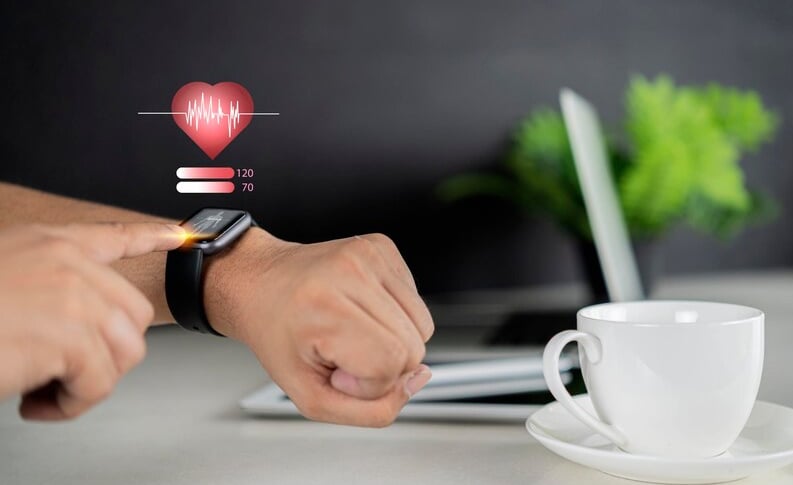How smartwatches can prove to be of great help for home healthcare staff and patients
Smartwatches as a healthcare game changer tech, right on your wrist


Healthcare is an ever-evolving field, with new technologies constantly emerging to help improve patient care and outcomes. One piece of wearable tech that is proving particularly useful for home healthcare is the smartwatch. These high-tech watches aren’t just for fitness fanatics and tech geeks anymore. Smartwatches are becoming invaluable tools for patients managing chronic health conditions at home, as well as the staff who care for them.
For Patients: Empowering Self-Management and Monitoring
For patients, especially those with chronic conditions like diabetes, heart disease or high blood pressure, smartwatches provide an easy way to monitor health stats and stay on top of wellness goals. Many smartwatches offer built-in health tracking features to measure things like heart rate, steps taken, calories burned and sleep quality. Some watches allow you to log other health metrics like blood glucose levels, blood pressure readings and medication intake.
Patients can share this data with their healthcare providers to identify health trends and get recommendations to better manage their condition. For some patients, especially the elderly or those with mobility issues, smartwatches provide a sense of security with features like fall detection and emergency alert systems. If there is a fall or other emergency, the smartwatch can automatically contact emergency responders or a designated emergency contact.
For Home Health Staff: Improving Care Management and Communication
For home health aides, nurses and other staff, smartwatches are revolutionizing the way they manage patient care. Staff can use smartwatches to receive alerts about health readings that are out of range, like high blood pressure or blood sugar levels, so they can quickly follow up with patients. Some smartwatch apps allow staff to send reminders to patients about medications, doctor visits or at-home care tasks. Staff can also use smartwatch GPS features to locate patients in case of emergencies.
To facilitate better communication, staff can send messages, photos and voice messages to patients and caregivers directly from a smartwatch. For home health agencies, smartwatches provide an opportunity to improve care coordination and outcomes across entire patient populations. With smartwatch data integrated into electronic health records, healthcare organizations get a more complete view of patient health and risks. They can then make more informed care management decisions and provide resources where they are needed most.
While smartwatches will not replace hands-on home healthcare, they provide an additional layer of connection between patients, staff and healthcare organizations. By leveraging the power of smartwatches, home healthcare can become even more personalized, proactive and effective. Patients and staff alike can feel confident in the knowledge that this life-saving technology is right at their fingertips – or rather, on their wrists.
Choosing a Smartwatch for Home Healthcare
With so many smartwatches on the market, how do you choose one suitable for home healthcare use? Here are some key features to consider:
• Health and fitness tracking: Look for a watch that measures heart rate, steps, sleep and other metrics relevant to the patient’s conditions. Some watches provide more advanced tracking for things like ECG, blood oxygen levels and fall detection.
• Battery life: For continuous health monitoring and emergency response, you'll want a watch with a long battery life, ideally 3-5 days between charges. Some watches also have "power saving" modes to extend battery life.
• Alerts and notifications: The ability to set up customized alerts and reminders is important for managing medications, doctor visits and health readings. Look for a watch that allows alerts to be customized and sent to the patient as well as staff and caregivers.
• GPS and emergency features: For patient safety, consider a watch with built-in GPS to pinpoint the patient's location in an emergency. An SOS button that can automatically call emergency responders is also useful.
• Compatibility with healthcare platforms: Some smartwatches interface directly with major electronic health records systems and health management platforms. This integration allows for easy sharing of health data and alerts between patients, staff and healthcare organizations.
• Simplicity: For elderly or technologically-challenged patients, choose a smartwatch that is simple to use with a minimal learning curve. Large, high-contrast displays with simple yes/no or one-touch buttons are most suitable. Some watches offer simplified interfaces specifically designed for older users.
• Budget-friendly options: While higher-end smartwatches from companies like Apple and Fitbit offer the latest health features, more affordable options are available. Look for watches from Amazfit, Xiaomi, Letsfit and other budget-friendly brands that provide basic health and safety features useful for home healthcare.
With the increasing use of smartwatches, especially among older populations, these devices are poised to become a standard tool for empowering patients and improving care in the home healthcare setting. By selecting a watch based on the needs and abilities of the patient, home healthcare staff can leverage this technology to facilitate better health outcomes and give patients the ability to confidently age in place. For healthcare organizations, investing in smartwatches provides an opportunity to enhance care, reduce costs and support the growing demand for home healthcare services.
